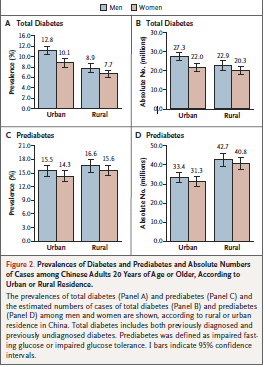Prevalence of Diabetes among Men and Women in China
08/04/2010
Cited from: Wenying Yang, N Engl J Med 2010;362:1090-101 Because of the rapid change in lifestyle in China, there is concern that diabetes may become epidemic. We conducted a national study from June 2007 through May 2008 to estimate the prevalence of diabetes among Chinese adults. **METHODS **A nationally representative sample of 46,239 adults, 20 years of age or older, from 14 provinces and municipalities participated in the study. After an overnight fast, participants underwent an oral glucose-tolerance test, and fasting and 2-hour glucose levels were measured to identify undiagnosed diabetes and prediabetes (i.e., impaired fasting glucose or impaired glucose tolerance). Previously diagnosed diabetes was determined on the basis of self-report. **RESULTS **The age-standardized prevalences of total diabetes (which included both previously diagnosed diabetes and previously undiagnosed diabetes) and prediabetes were 9.7% (10.6% among men and 8.8% among women) and 15.5% (16.1% among men and 14.9% among women), respectively, accounting for 92.4 million adults with diabetes (50.2 million men and 42.2 million women) and 148.2 million adults with prediabetes (76.1 million men and 72.1 million women). The prevalence of diabetes increased with increasing age (3.2%, 11.5%, and 20.4% among persons who were 20 to 39, 40 to 59, and ≥60 years of age, respectively) and with increasing weight (4.5%, 7.6%, 12.8%, and 18.5% among persons with a body-mass index [the weight in kilograms divided by the square of the height in meters] of **CONCLUSIONS **These results indicate that diabetes has become a major public health problem in China and that strategies aimed at the prevention and treatment of diabetes are needed.
Prevalence of Diabetes among Men and Women in ChinaNews - Apr. 8, 2010
Cited from: Wenying Yang, N Engl J Med 2010;362:1090-101
Cardiovascular disease has become the leading cause of death in China, a development that has followed rapid economic
growth, an increase in life expectancy, and changes in lifestyle.1 Diabetes is a major risk factor for cardiovascular disease, and the prevalence of diabetes is high and is increasing in China.2-4. A national survey conducted in 1994, involving
224,251 Chinese residents, 25 to 64 years of age, from 19 provinces, showed that the prevalences of diabetes and impaired glucose tolerance were 2.5% and 3.2%, respectively.2 These estimates were higher by a factor of approximately 3 than those reported in 1980.3 In a cross-sectional study in 2000–2001 involving a nationally representative sample of 15,540 adults, 35 to 74 years of age, the prevalences of diabetes and impaired fasting glucose were 5.5% and 7.3%, respectively.4 Although these studies have documented a marked increase in the prevalence of diabetes in China, they cannot be compared directly, owing to methodologic differences in sampling and to differences in the criteria used to define diabetes.2-4 Furthermore, the prevalences of diabetes and prediabetes were probably underestimated in these studies because 2-hour oral glucose-tolerance tests were not performed in all participants. It has been suggested that isolated hyperglycemia 2 hours after glucose loading is common among Asian patients with diabetes.5 For example, in the Shanghai Diabetes Study, 48.6% of patients with newly diagnosed diabetes had isolated hyperglycemia 2 hours after glucose loading, and 75.0% of those with prediabetes had isolated impaired glucose tolerance.6
The China National Diabetes and Metabolic Disorders Study, conducted from June 2007 through May 2008, was a cross-sectional study designed to provide current and reliable data on the prevalences of diabetes and associated metabolic risk
factors in the adult population in China.
Abstract
Because of the rapid change in lifestyle in China, there is concern that diabetes may become epidemic. We conducted a national study from June 2007 through May 2008 to estimate the prevalence of diabetes among Chinese adults.METHODS
A nationally representative sample of 46,239 adults, 20 years of age or older, from 14 provinces and municipalities participated in the study. After an overnight fast, participants underwent an oral glucose-tolerance test, and fasting and 2-hour glucose levels were measured to identify undiagnosed diabetes and prediabetes (i.e., impaired fasting glucose or impaired glucose tolerance). Previously diagnosed diabetes was determined on the basis of self-report.
RESULTS
The age-standardized prevalences of total diabetes (which included both previously diagnosed diabetes and previously undiagnosed diabetes) and prediabetes were 9.7% (10.6% among men and 8.8% among women) and 15.5% (16.1% among men and 14.9% among women), respectively, accounting for 92.4 million adults with diabetes (50.2 million men and 42.2 million women) and 148.2 million adults with prediabetes (76.1 million men and 72.1 million women). The prevalence of diabetes increased with increasing age (3.2%, 11.5%, and 20.4% among persons who were 20 to 39, 40 to 59, and ≥60 years of age, respectively) and with increasing weight (4.5%, 7.6%, 12.8%, and 18.5% among persons with a body-mass index [the weight in kilograms divided by the square of the height in meters] of <18.5, 18.5 to 24.9, 25.0 to 29.9, and ≥30.0, respectively). The prevalence of diabetes was higher among urban residents than among rural residents (11.4% vs. 8.2%). The prevalence of isolated impaired glucose tolerance was higher than that of isolated impaired fasting glucose (11.0% vs. 3.2% among men and 10.9% vs. 2.2% among women).
CONCLUSIONS
These results indicate that diabetes has become a major public health problem in China and that strategies aimed at the prevention and treatment of diabetes are needed.

